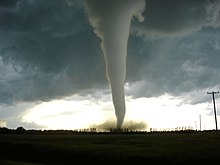| Tornado | |
|---|---|
 | |
| Area of occurrence | North America (particularly in central and southeastern regions of the United States colloquially known as Tornado Alley), South Africa, much of Europe (except most of the Alps), western and eastern Australia, New Zealand, Bangladesh and adjacent eastern India, Japan, the Philippines, and southeastern South America (Uruguay and Argentina) |
| Season | Primarily spring and summer, but can occur at any time of year with the right atmospheric conditions |
| Effect | Wind damage |
| Part of a series on |
| Weather |
|---|
|
|
A tornado is a violently rotating column of air that is in contact with both the surface of the Earth and a cumulonimbus cloud or, in rare cases, the base of a cumulus cloud. It is often referred to as a twister, whirlwind or cyclone,[1] although the word cyclone is used in meteorology to name a weather system with a low-pressure area in the center around which, from an observer looking down toward the surface of the Earth, winds blow counterclockwise in the Northern Hemisphere and clockwise in the Southern.[2] Tornadoes come in many shapes and sizes, and they are often (but not always) visible in the form of a condensation funnel originating from the base of a cumulonimbus cloud, with a cloud of rotating debris and dust beneath it. Most tornadoes have wind speeds less than 180 kilometers per hour (110 miles per hour), are about 80 meters (250 feet) across, and travel several kilometers (a few miles) before dissipating. The most extreme tornadoes can attain wind speeds of more than 480 kilometers per hour (300 mph), can be more than 3 kilometers (2 mi) in diameter, and can stay on the ground for more than 100 km (62 mi).[3][4][5]
Various types of tornadoes include the multiple-vortex tornado, landspout, and waterspout. Waterspouts are characterized by a spiraling funnel-shaped wind current, connecting to a large cumulus or cumulonimbus cloud. They are generally classified as non-supercellular tornadoes that develop over bodies of water, but there is disagreement over whether to classify them as true tornadoes. These spiraling columns of air frequently develop in tropical areas close to the equator and are less common at high latitudes.[6] Other tornado-like phenomena that exist in nature include the gustnado, dust devil, fire whirl, and steam devil.
Tornadoes occur most frequently in North America (particularly in central and southeastern regions of the United States colloquially known as Tornado Alley; the United States has by far the most tornadoes of any country in the world).[7] Tornadoes also occur in South Africa, much of Europe (except most of the Alps), western and eastern Australia, New Zealand, Bangladesh and adjacent eastern India, Japan, the Philippines, and southeastern South America (Uruguay and Argentina).[8][9] Tornadoes can be detected before or as they occur through the use of pulse-Doppler radar by recognizing patterns in velocity and reflectivity data, such as hook echoes or debris balls, as well as through the efforts of storm spotters.[10][11]
- ^ "merriam-webster.com". merriam-webster.com. Archived from the original on 2017-07-09. Retrieved 2012-09-03.
- ^ Garrison, Tom (2012). Essentials of Oceanography. Cengage Learning. ISBN 978-0-8400-6155-3.
- ^ Wurman, Joshua (2008-08-29). "Doppler on Wheels". Center for Severe Weather Research. Archived from the original on 2007-02-05. Retrieved 2009-12-13.
- ^ "Hallam Nebraska Tornado". National Weather Service. National Oceanic and Atmospheric Administration. 2005-10-02. Archived from the original on 2013-04-30. Retrieved 2009-11-15.
- ^ Edwards, Roger (2006-04-04). "The Online Tornado FAQ". Storm Prediction Center. National Oceanic and Atmospheric Administration. Archived from the original on 2006-09-29. Retrieved 2006-09-08.
 This article incorporates text from this source, which is in the public domain.
This article incorporates text from this source, which is in the public domain.
- ^ National Weather Service (2009-02-03). "15 January 2009: Lake Champlain Sea Smoke, Steam Devils, and Waterspout: Chapters IV and V". National Oceanic and Atmospheric Administration. Archived from the original on 2016-01-01. Retrieved 2009-06-21.
- ^ "Tornado Alley, USA: Science News Online, May 11, 2002". 25 August 2006. Archived from the original on 25 August 2006.
- ^ Cite error: The named reference
EB tornado climatologywas invoked but never defined (see the help page). - ^ "TORNADO CENTRAL, Where Tornadoes Strike Around the World, February 12, 2018". 12 February 2018. Archived from the original on 30 September 2021. Retrieved 30 September 2021.
- ^ Coleman, Timothy A.; Knupp, Kevin R.; Spann, James; Elliott, J. B.; Peters, Brian E. (2011-05-01). "The History (and Future) of Tornado Warning Dissemination in the United States". Bulletin of the American Meteorological Society. 92 (5): 567–582. Bibcode:2011BAMS...92..567C. doi:10.1175/2010BAMS3062.1.
- ^ Ahrens, C. Donald (2016). Meteorology today: an introduction to weather, climate, and the environment (11th ed.). Boston, MA, USA: Cengage Learning. ISBN 978-1-305-11358-9.